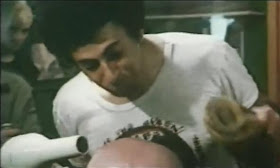Amongst some would-be radicals there is a deep loathing of popular culture that can come across as very patronising. You know the sort of thing - 'TV is for fools and the masses' interest in celebrities just shows that they are dupes of the system' etc. etc. Sometimes this critique is dressed up in language about 'the spectacle', with a suggestion that music, TV and film simply create passive consumers unable to think or act for themselves. The notion of the
Society of the Spectacle derives from Guy Debord and the
Situationist International in the 1960s, though it has to be said that their notion of it is more sophisticated than the cod-situ version sometimes spouted today - certainly little trace of any moralistic condemnation of 'consumerism'.
One man who knows more about the situationists than most is Fred Vermorel. He was actually in Paris during the events of May 1968, in which the situationists were actively involved, and indeed shortly after played a critical if inadvertent role in cultural history when he introduced his friend Malcolm McLaren to the work of the Situationist International at the '36 bus stop, just outside Goldsmiths College in Lewisham Way'. Vermorel was living in Jerningham Road, New Cross at this time (
more about this here). McLaren of course went on to manage the Sex Pistols, some would say applying some ideas he culled from the situationists - a connection made by Fred and Judy Vermorel in their 1978 book Sex Pistols: the inside story'.
Vermorel's take on 'fandom' is quite distinctive. In Starlust: the Secret Life of Fans (1985), Fred and Judy Vermorel collected together the fantasies of music fans with a suggestion that they reflected a kind of 'utopian romanticism' - a desire for a more intense way of life that sometimes exceeded the limits set for it by the cultural industry, in its own way potentially subversive.
Since then Vermorel has written a number of books which could be described as celebrity biogs, with subjects including Kate Bush, Vivienne Westwood, and Kate Moss. To an extent Vermorel inhabits the mindset of the obsessive fan in his books, trawling tabloids and acquaintances for tales of sex, drugs and scandals, as well as the micro-detail of celebrity trivia. But these are also biogs with a difference - for instance the Kate Bush book includes genealogical research on her forebears in Kent, and the Westwood one includes fictional first person narrative.

'Kate Moss: Addicted to Love' (2006) starts with reflections on her 'Croydon' origins, or rather as Vermorel points out the leafier suburbs of the Croydon area: 'Forget Croydon. That is a fantasy she likes to spread as much as the media does. A supermodel from Croydon: beauty flowering out of the concrete towered, motorway infested, chav ridden wastelands... Sanderstead... is where Kate Moss really comes from - spiritually as well as spatially. "Croydon" may be the general area, and convenient shorthand, but Sanderstead - suburbia, is what's inside her'.
Vermorel then goes on to detail Kate's South London life - birth in St Mary's Hospital, Croydon; a short period at Pagehurst Road, Addiscombe then growing up at 75 Church Way, Sanderstead; Ridgeway Primary School; Riddlesdown High School; hanging out with the teenage drinkers and smokers in Purley Town Centre; moving in with her mum in Forestdale when her parents split up; meeting early boyfriends in Croydon wine bar Rue St George - then after being spotted at an airport on to The Face, Johnny Depp (who told Vanity Fair in 1997 'man, you can't beat that South London accent'), Pete Doherty, 'Cocaine Kate' and all the rest.
This is definitely in the mainstream 'unauthorised' celebrity biography genre, rather than some kind of cultural studies text, but Vermorel does slip in the odd Burroughs and Baudrillard quote and some wider reflections on the relationships between celebrity, money and drugs:
'There are parallels in how celebrity works, and how money works. Both celebrity and money are formless and yet endlessly mutable... They both originate in magic belief, and their extraordinary power to reproduce and migrate across culture comes from their 'super-objective' quality: they are beyond everything yet inside everything. The stock exchange and the hit parades both float on fetishes of reputation - and of number... the essence of any celebrity is not anything instrinsic to the person who bears the Name - the magic is in the numbers - of hits, of clicks, of number ones and top tens, the milliosn of fans or $s or £s that accrue to that 'personality''.
And:
'Heroin stands for money - trade - turnover - feverish spending - sales bonanzas - overnight fortunes - role reversals - and amazing good luck. It equally signifies fashion, which is the pulse of pure consumerism. Heroin, as the ideal commodity, creates perfect consumers... No surprize then, the trade off between those ultimate icons of conusmerism, models, and those ultimate consumers, junkies. Both work from wasted bodies and freak energies, they live on the margins of the tragic and the phantasmagorical - between the next frock and the next fix'.
.






















































